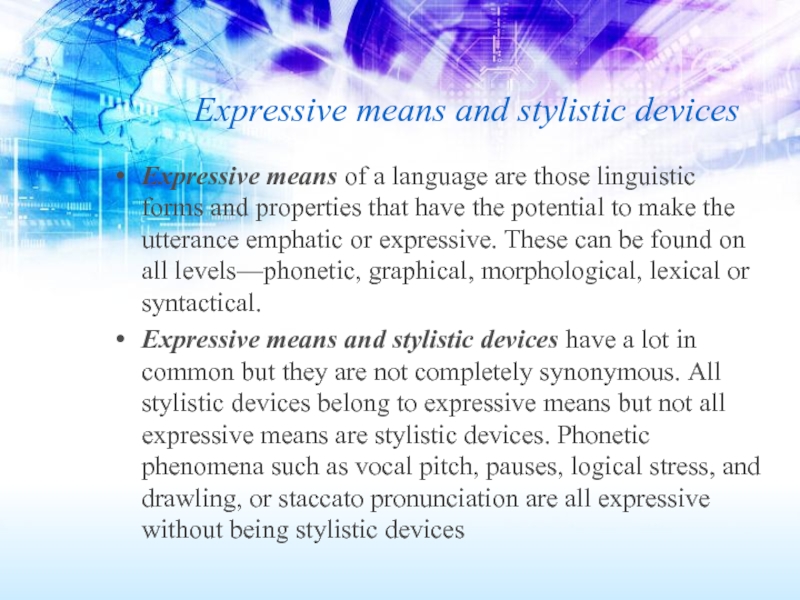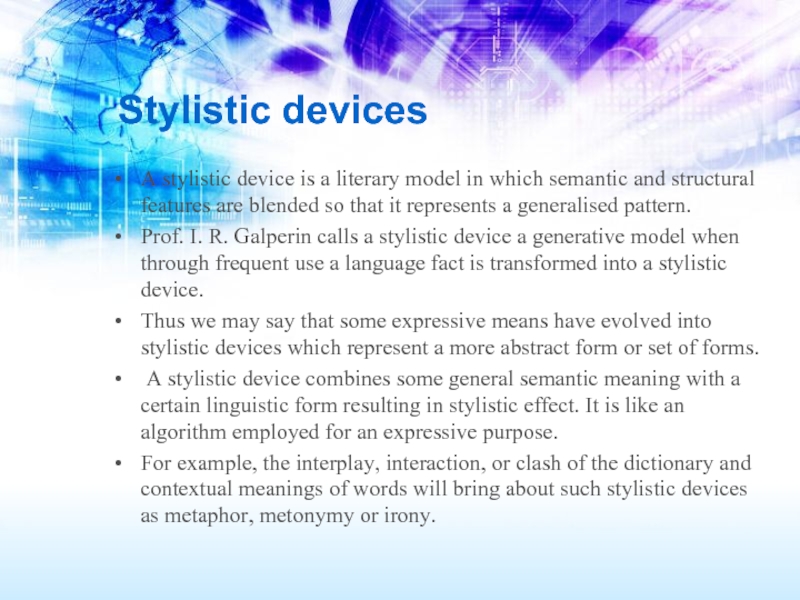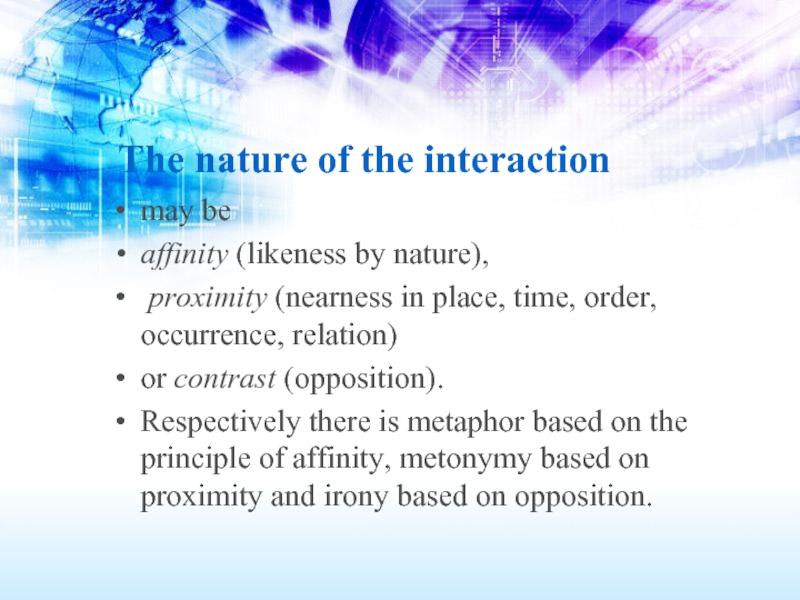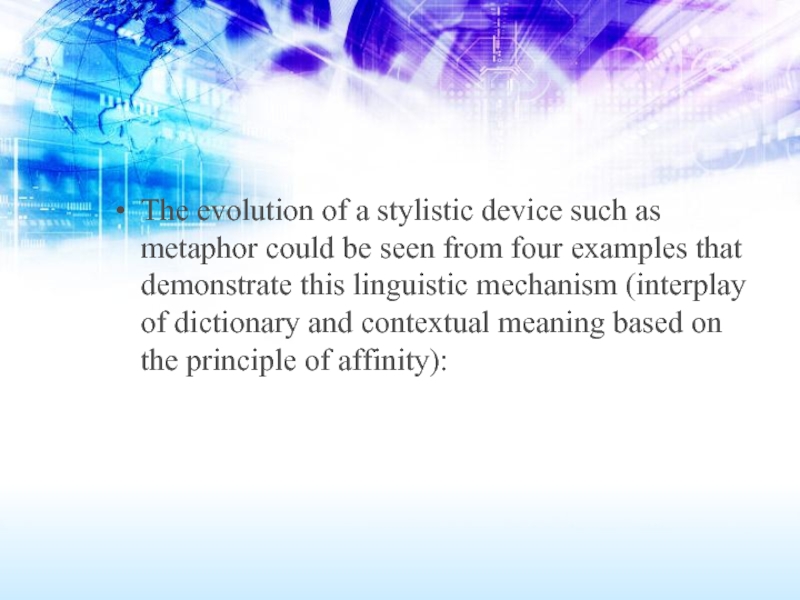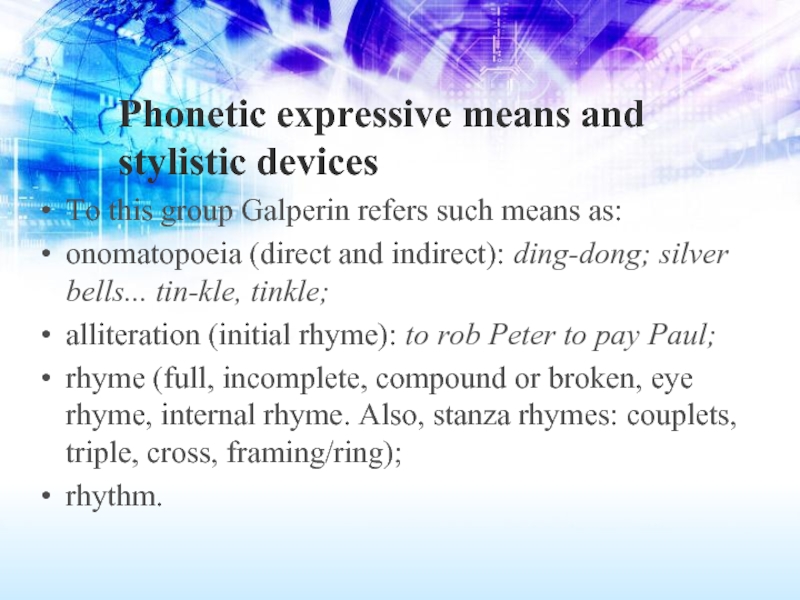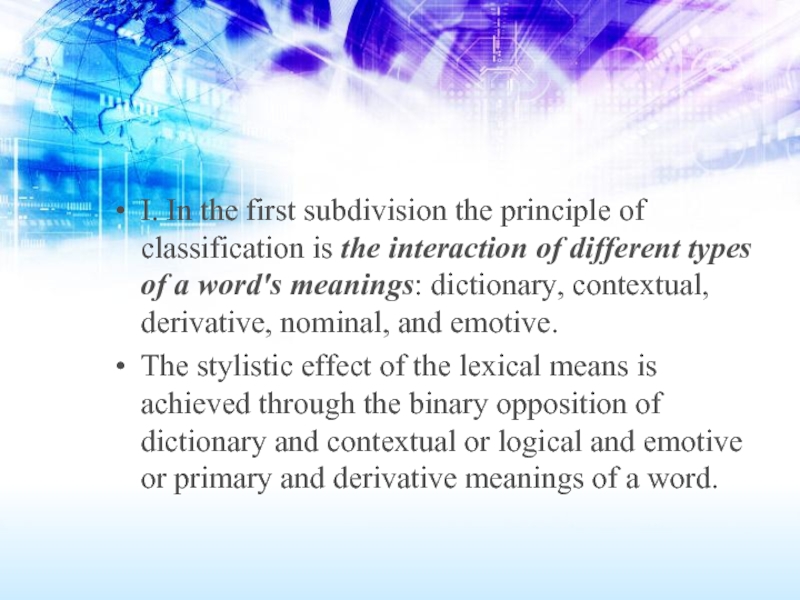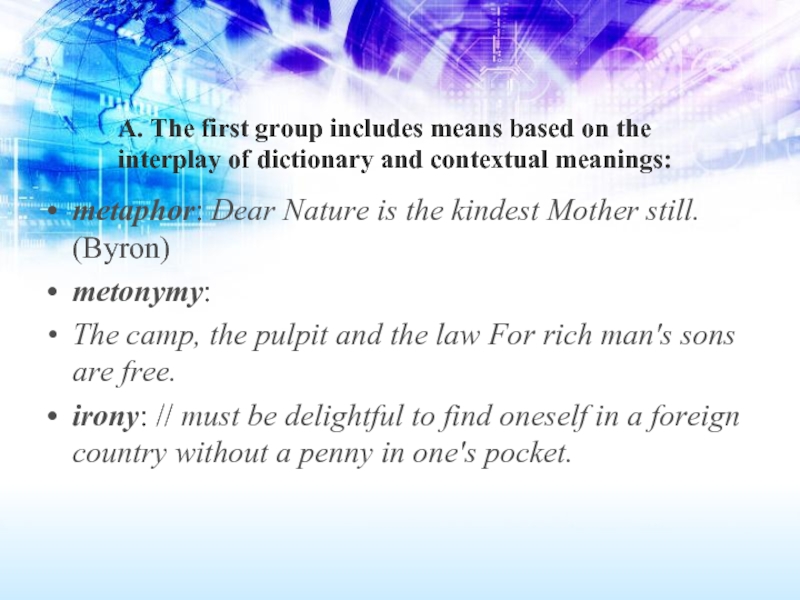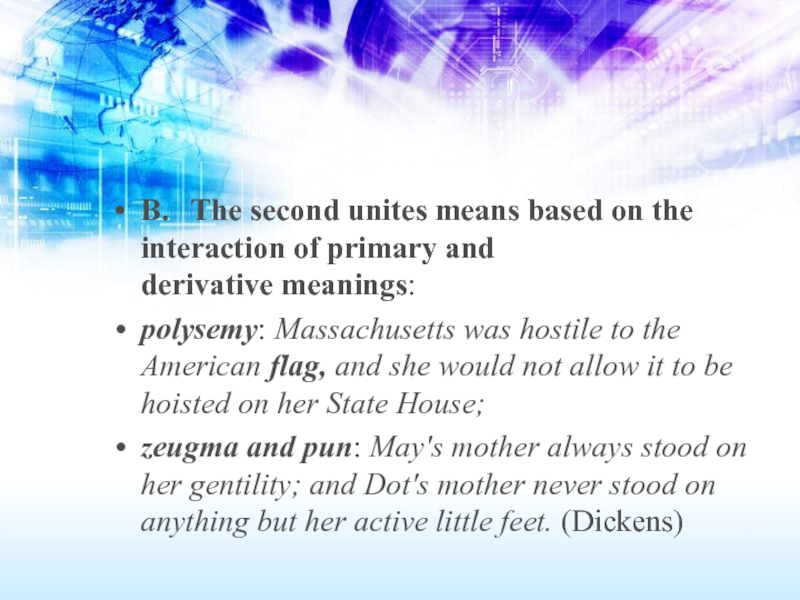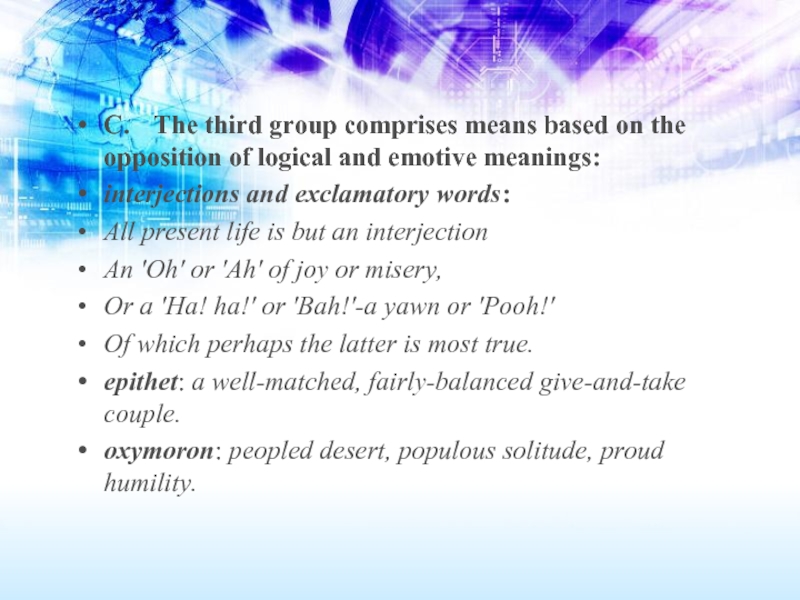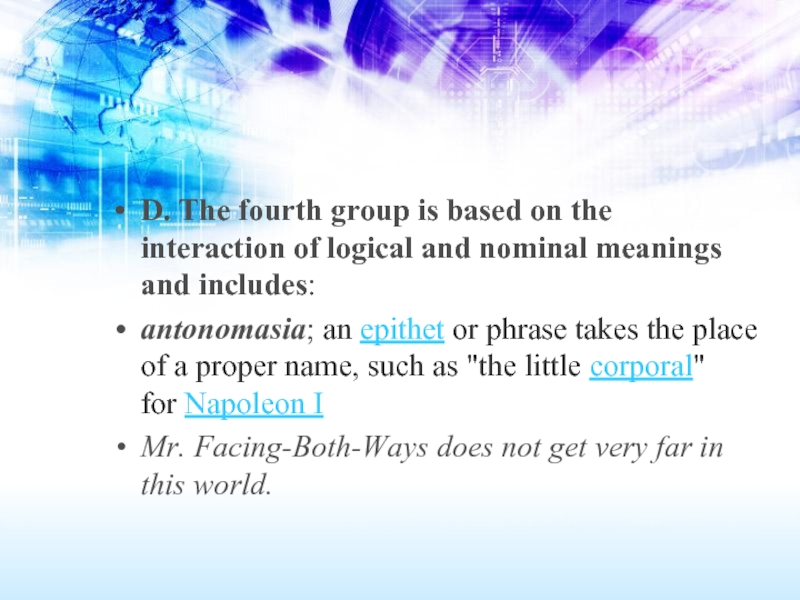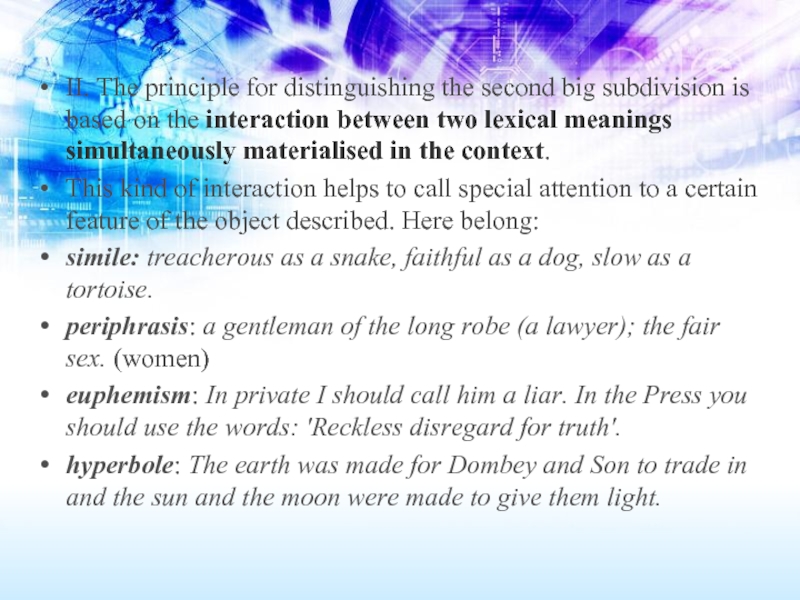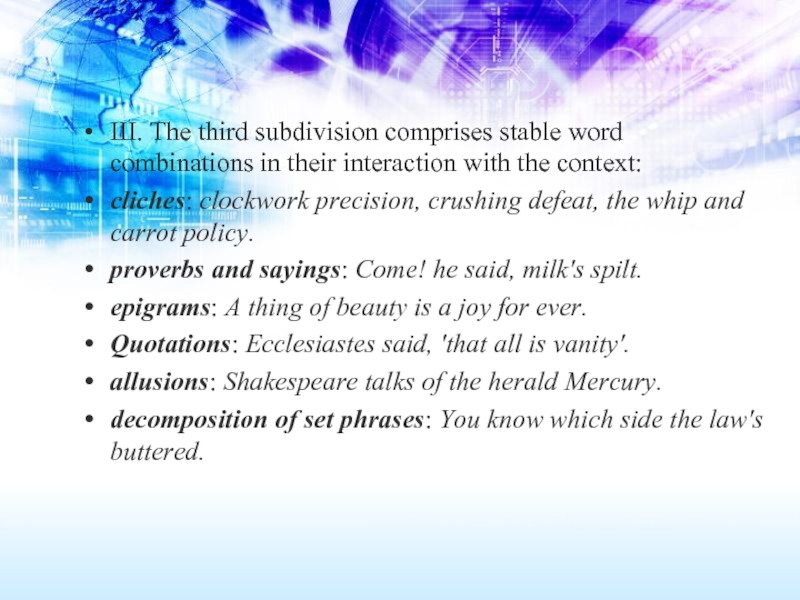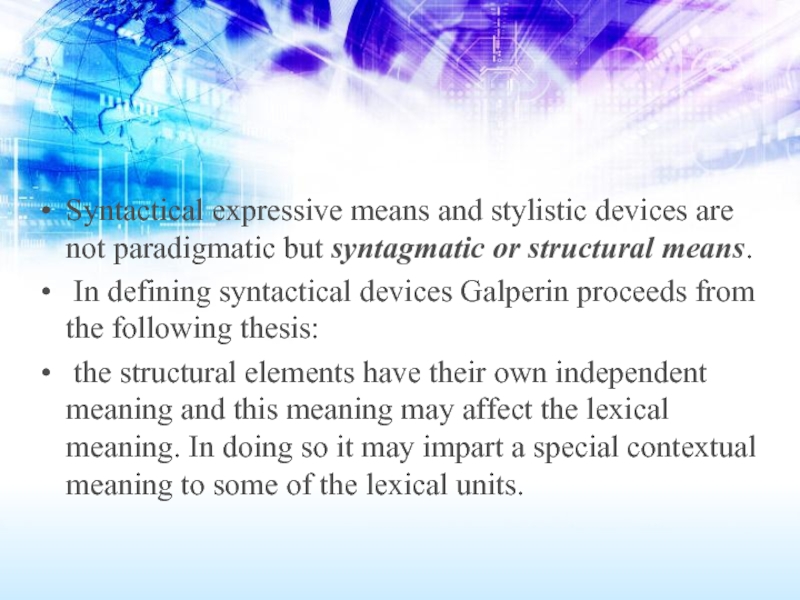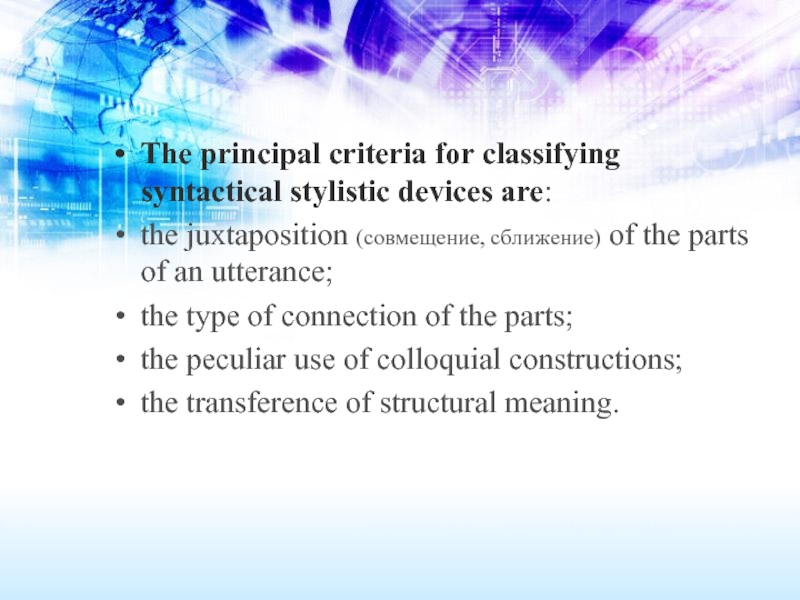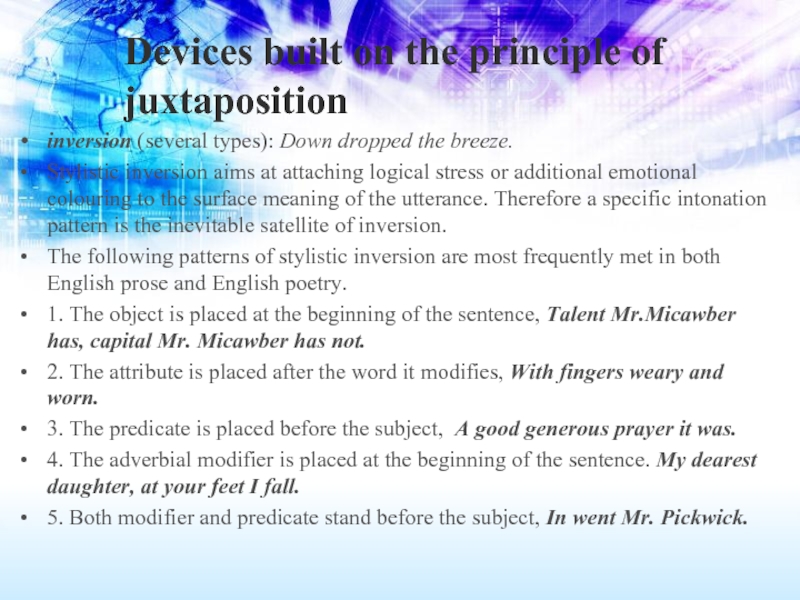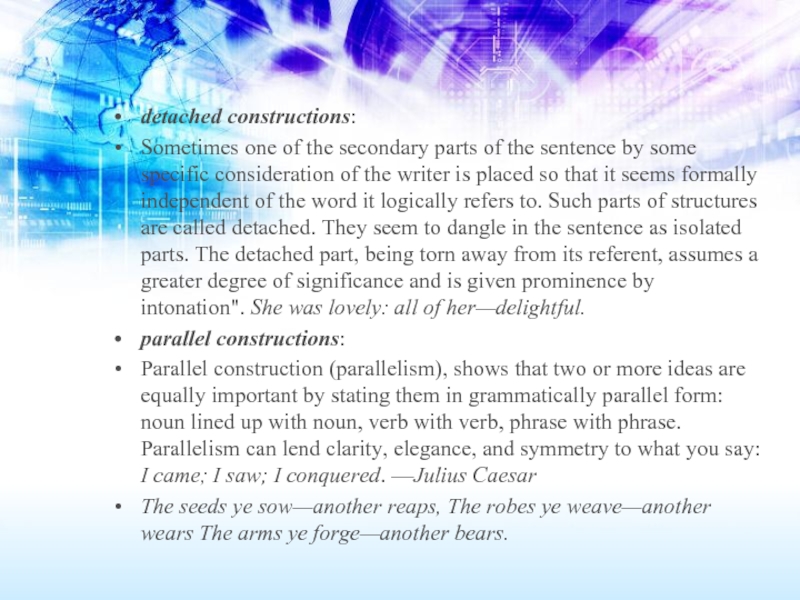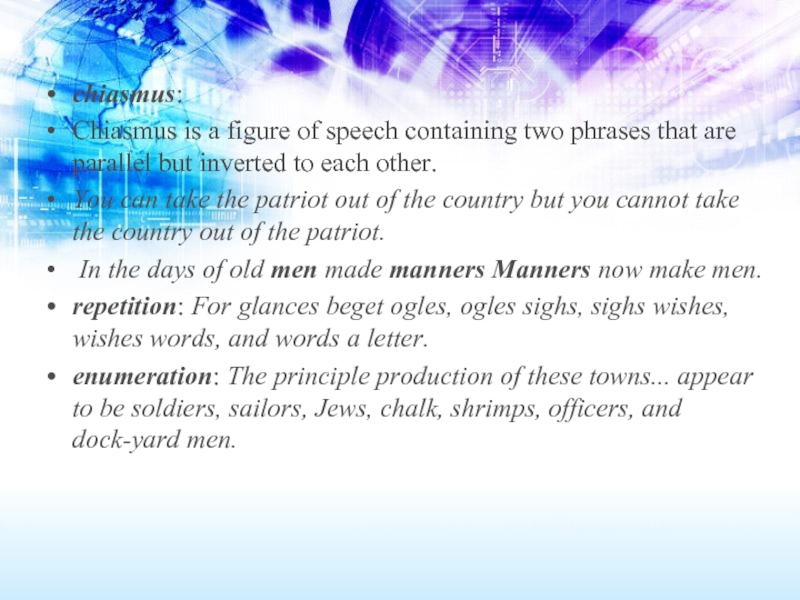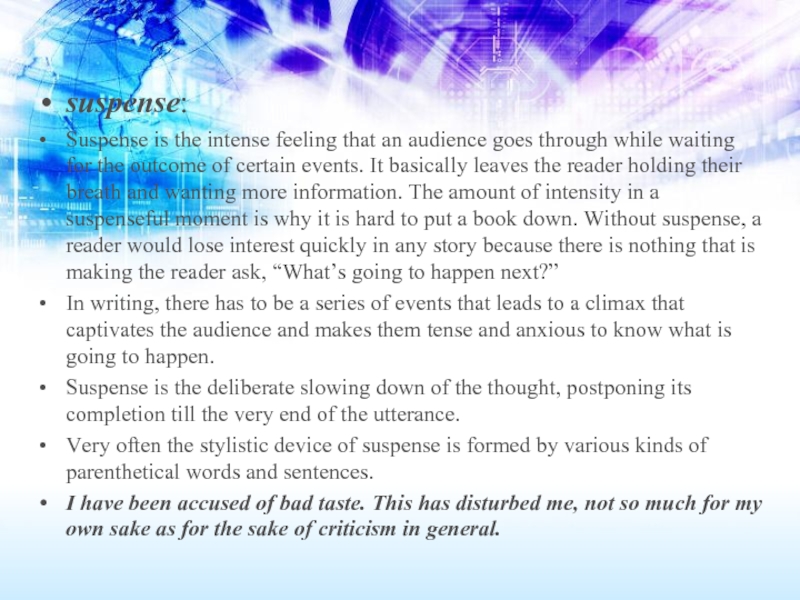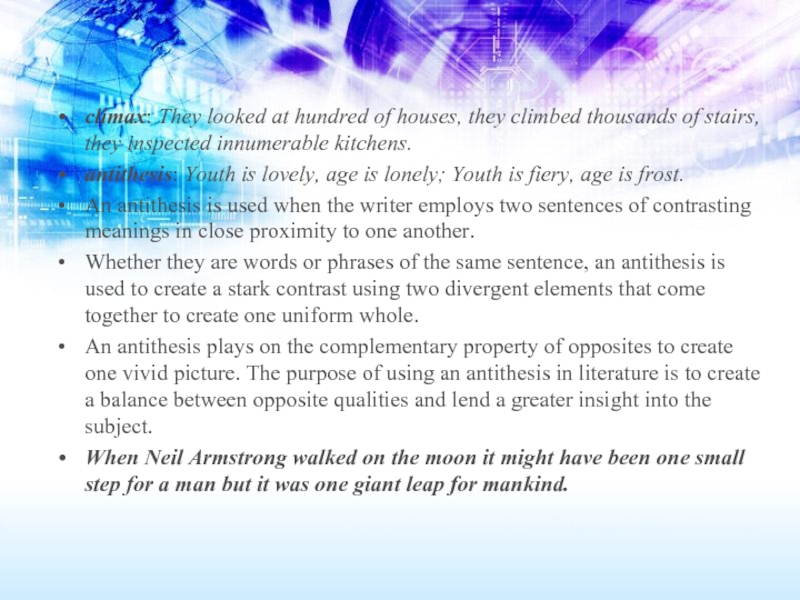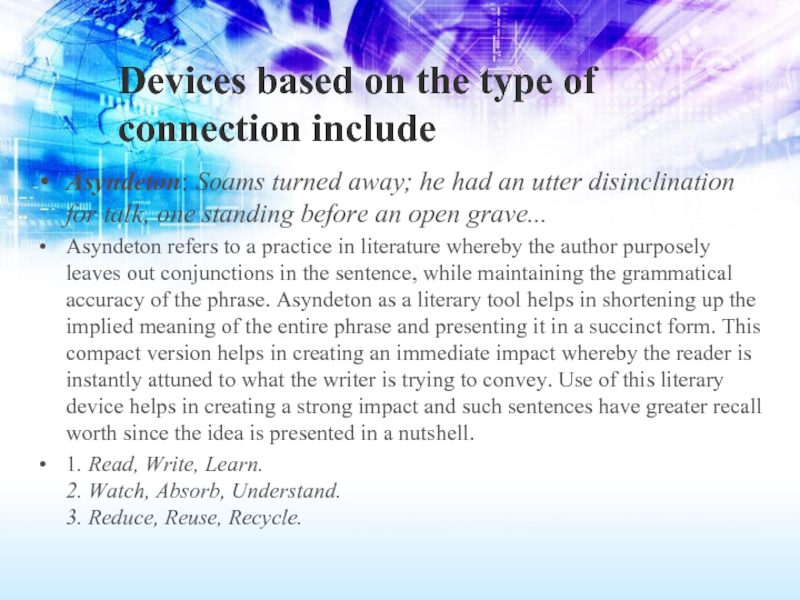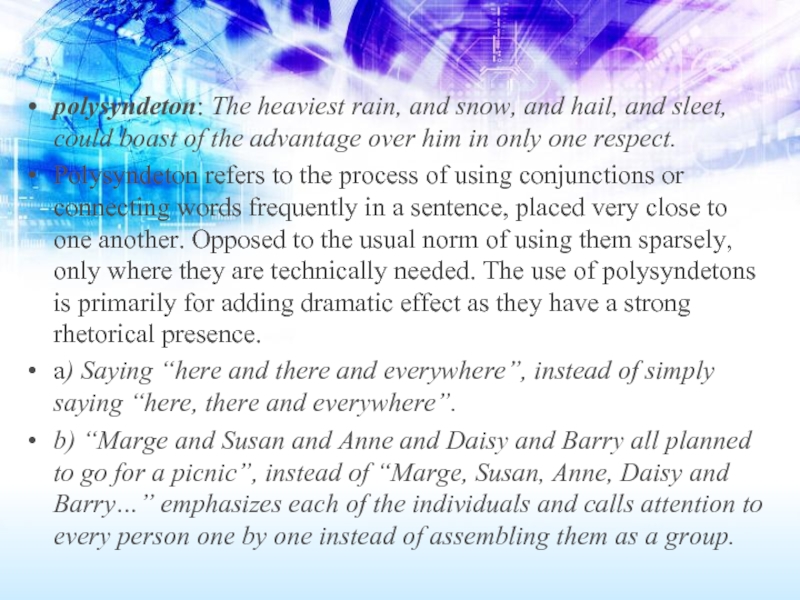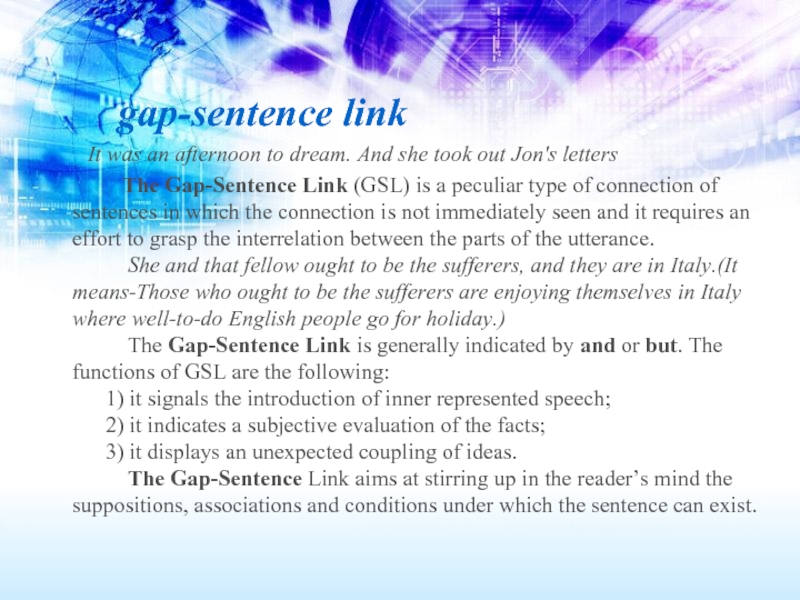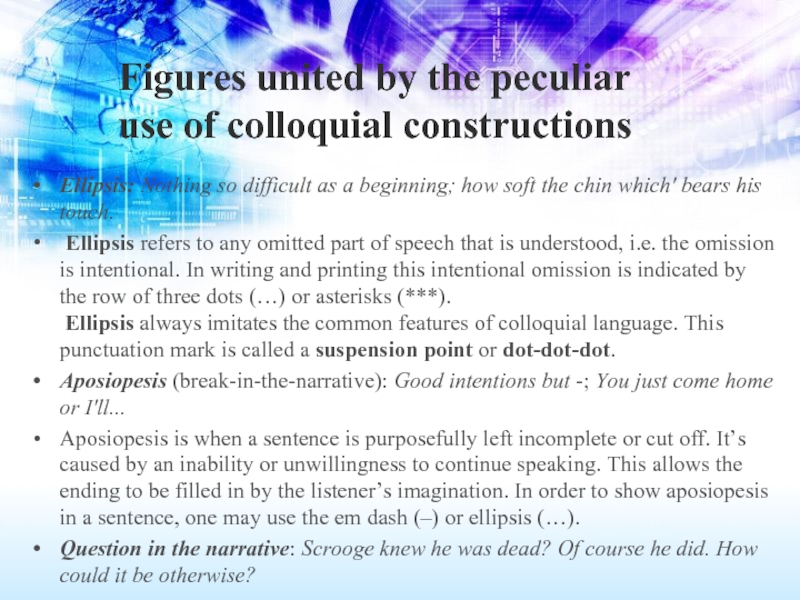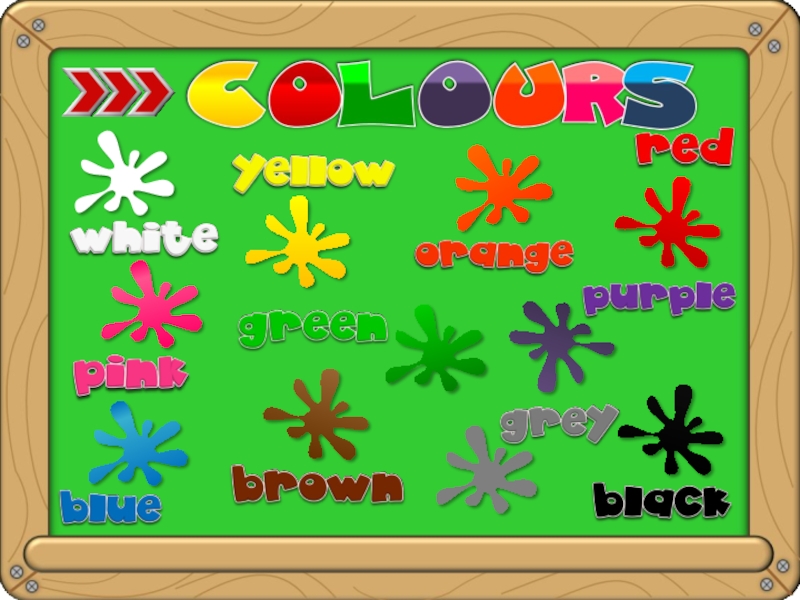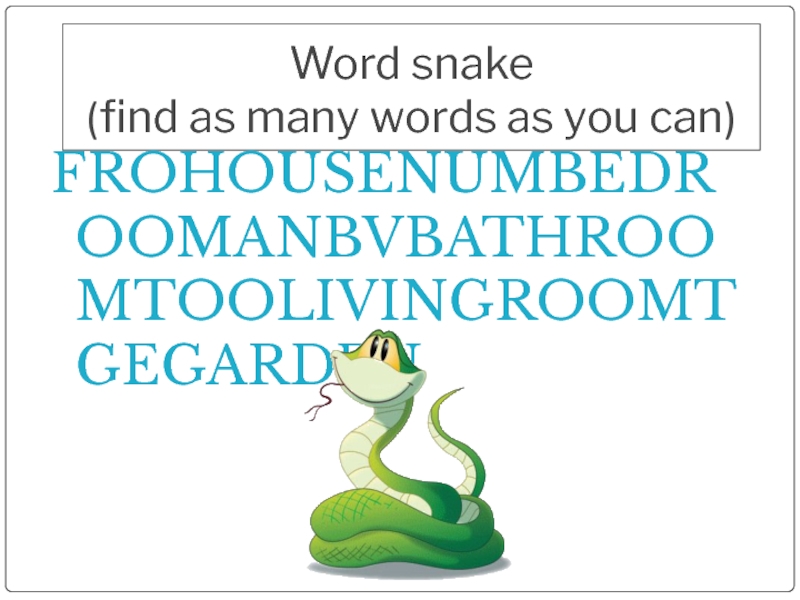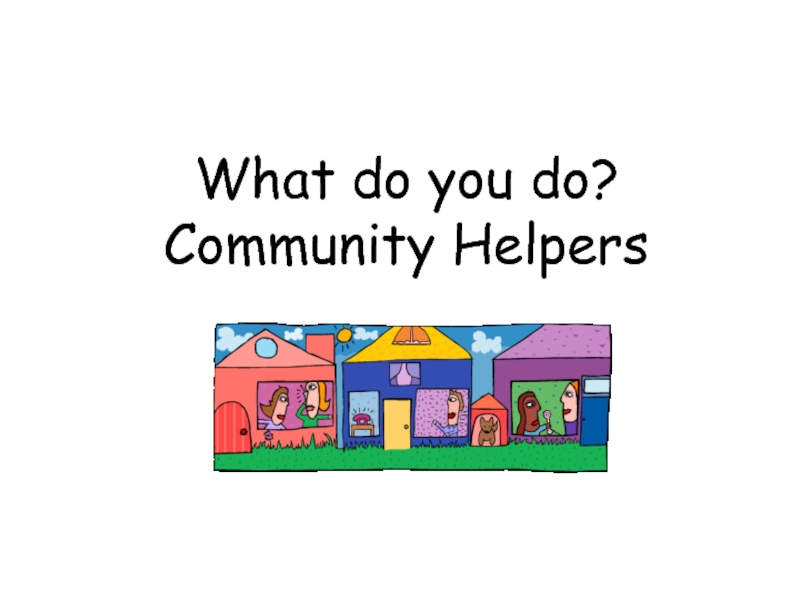- Главная
- Разное
- Дизайн
- Бизнес и предпринимательство
- Аналитика
- Образование
- Развлечения
- Красота и здоровье
- Финансы
- Государство
- Путешествия
- Спорт
- Недвижимость
- Армия
- Графика
- Культурология
- Еда и кулинария
- Лингвистика
- Английский язык
- Астрономия
- Алгебра
- Биология
- География
- Детские презентации
- Информатика
- История
- Литература
- Маркетинг
- Математика
- Медицина
- Менеджмент
- Музыка
- МХК
- Немецкий язык
- ОБЖ
- Обществознание
- Окружающий мир
- Педагогика
- Русский язык
- Технология
- Физика
- Философия
- Химия
- Шаблоны, картинки для презентаций
- Экология
- Экономика
- Юриспруденция
Expressive means and stylistic devices презентация
Содержание
- 1. Expressive means and stylistic devices
- 2. Expressive means and stylistic devices Expressive means
- 3. Morphological forms like diminutive suffixes may have
- 4. Stylistic devices A stylistic device is
- 5. The nature of the interaction may
- 6. The evolution of a stylistic device such
- 7. 1. My new dress is as
- 8. I. R. Galperin's classification of expressive means
- 9. Phonetic stylistic devices
- 10. Phonetic expressive means and stylistic devices To
- 11. Lexical stylistic devices
- 12. Lexical expressive means and stylistic devices
- 13. I. In the first subdivision the principle
- 14. A. The first group includes means based
- 15. B. The second unites means based on the
- 16. C. The third group comprises means based on
- 17. D. The fourth group is based on
- 18. II. The principle for distinguishing the second
- 19. Ш. The third subdivision comprises stable word
- 20. Syntactical stylistic devices
- 21. Syntactical expressive means and stylistic devices are
- 22. The principal criteria for classifying syntactical stylistic
- 23. Devices built on the principle of juxtaposition
- 24. detached constructions: Sometimes one of the
- 25. chiasmus: Chiasmus is a figure of speech
- 26. suspense: Suspense is the intense feeling
- 27. climax: They looked at hundred of houses,
- 28. Devices based on the type of connection
- 29. polysyndeton: The heaviest rain, and snow, and
- 30. gap-sentence link It was an afternoon
- 31. Figures united by the peculiar use of
- 32. Represented speech (uttered and unuttered or inner
- 33. Transferred use of structural meaning involves such
Слайд 2Expressive means and stylistic devices
Expressive means of a language are those
linguistic forms and properties that have the potential to make the utterance emphatic or expressive. These can be found on all levels—phonetic, graphical, morphological, lexical or syntactical.
Expressive means and stylistic devices have a lot in common but they are not completely synonymous. All stylistic devices belong to expressive means but not all expressive means are stylistic devices. Phonetic phenomena such as vocal pitch, pauses, logical stress, and drawling, or staccato pronunciation are all expressive without being stylistic devices
Expressive means and stylistic devices have a lot in common but they are not completely synonymous. All stylistic devices belong to expressive means but not all expressive means are stylistic devices. Phonetic phenomena such as vocal pitch, pauses, logical stress, and drawling, or staccato pronunciation are all expressive without being stylistic devices
Слайд 3Morphological forms like diminutive suffixes may have an expressive effect: girlie,
piggy, doggy, etc. An unexpected use of the author's nonce words like: He glasnosted his love affair with the movie star is another example of morphological expressive means.
Lexical expressive means may be illustrated by a special group о intensifiers—awfully, terribly, absolutely, etc. or words that retain their logical meaning while being used emphatically: / was a very sped evening/event/gift.
There are also special grammatical forms and syntactical patterns attributing expressiveness, such as: / do know you! I'm really angry with that dog of у ours! That you should deceive me! If only I could help you!
Lexical expressive means may be illustrated by a special group о intensifiers—awfully, terribly, absolutely, etc. or words that retain their logical meaning while being used emphatically: / was a very sped evening/event/gift.
There are also special grammatical forms and syntactical patterns attributing expressiveness, such as: / do know you! I'm really angry with that dog of у ours! That you should deceive me! If only I could help you!
Слайд 4Stylistic devices
A stylistic device is a literary model in which semantic
and structural features are blended so that it represents a generalised pattern.
Prof. I. R. Galperin calls a stylistic device a generative model when through frequent use a language fact is transformed into a stylistic device.
Thus we may say that some expressive means have evolved into stylistic devices which represent a more abstract form or set of forms.
A stylistic device combines some general semantic meaning with a certain linguistic form resulting in stylistic effect. It is like an algorithm employed for an expressive purpose.
For example, the interplay, interaction, or clash of the dictionary and contextual meanings of words will bring about such stylistic devices as metaphor, metonymy or irony.
Prof. I. R. Galperin calls a stylistic device a generative model when through frequent use a language fact is transformed into a stylistic device.
Thus we may say that some expressive means have evolved into stylistic devices which represent a more abstract form or set of forms.
A stylistic device combines some general semantic meaning with a certain linguistic form resulting in stylistic effect. It is like an algorithm employed for an expressive purpose.
For example, the interplay, interaction, or clash of the dictionary and contextual meanings of words will bring about such stylistic devices as metaphor, metonymy or irony.
Слайд 5The nature of the interaction
may be
affinity (likeness by nature),
proximity (nearness in place, time, order, occurrence, relation)
or contrast (opposition).
Respectively there is metaphor based on the principle of affinity, metonymy based on proximity and irony based on opposition.
or contrast (opposition).
Respectively there is metaphor based on the principle of affinity, metonymy based on proximity and irony based on opposition.
Слайд 6The evolution of a stylistic device such as metaphor could be
seen from four examples that demonstrate this linguistic mechanism (interplay of dictionary and contextual meaning based on the principle of affinity):
Слайд 7
1. My new dress is as pink as this flower: comparison
(ground for comparison—the colour of the flower).
2. Her cheeks were as red as a tulip: simile (ground for simile— colour/beauty/health/freshness)
3. She is a real flower: metaphor (ground for metaphor—frail/ fragrant/tender/beautiful/helpless...). My love is a red, red rose: metaphor (ground for metaphor— passionate/beautiful/strong...).
4. Ruby lips, hair of gold, snow-white skin: trite metaphors so frequently employed that they hardly have any stylistic power left because metaphor dies of overuse. Such metaphors are also called hackneyed or even dead.
2. Her cheeks were as red as a tulip: simile (ground for simile— colour/beauty/health/freshness)
3. She is a real flower: metaphor (ground for metaphor—frail/ fragrant/tender/beautiful/helpless...). My love is a red, red rose: metaphor (ground for metaphor— passionate/beautiful/strong...).
4. Ruby lips, hair of gold, snow-white skin: trite metaphors so frequently employed that they hardly have any stylistic power left because metaphor dies of overuse. Such metaphors are also called hackneyed or even dead.
Слайд 8I. R. Galperin's classification of expressive means and stylistic devices
The classification
suggested by Prof. Galperin is simply organised and very detailed. His manual «Stylistics» published in 1971 includes the following subdivision of expressive means and stylistic devices based on the level-oriented approach:
Phonetic expressive means and stylistic devices.
Lexical expressive means and stylistic devices.
Syntactical expressive means and stylistic devices.
Phonetic expressive means and stylistic devices.
Lexical expressive means and stylistic devices.
Syntactical expressive means and stylistic devices.
Слайд 10Phonetic expressive means and stylistic devices
To this group Galperin refers such
means as:
onomatopoeia (direct and indirect): ding-dong; silver bells... tinkle, tinkle;
alliteration (initial rhyme): to rob Peter to pay Paul;
rhyme (full, incomplete, compound or broken, eye rhyme, internal rhyme. Also, stanza rhymes: couplets, triple, cross, framing/ring);
rhythm.
onomatopoeia (direct and indirect): ding-dong; silver bells... tinkle, tinkle;
alliteration (initial rhyme): to rob Peter to pay Paul;
rhyme (full, incomplete, compound or broken, eye rhyme, internal rhyme. Also, stanza rhymes: couplets, triple, cross, framing/ring);
rhythm.
Слайд 12Lexical expressive means and stylistic devices
There are three big subdivisions in
this class of devices and they all deal with the semantic nature of a word or phrase.
However the criteria of selection of means for each subdivision are different and manifest different semantic processes.
However the criteria of selection of means for each subdivision are different and manifest different semantic processes.
Слайд 13I. In the first subdivision the principle of classification is the
interaction of different types of a word's meanings: dictionary, contextual, derivative, nominal, and emotive.
The stylistic effect of the lexical means is achieved through the binary opposition of dictionary and contextual or logical and emotive or primary and derivative meanings of a word.
The stylistic effect of the lexical means is achieved through the binary opposition of dictionary and contextual or logical and emotive or primary and derivative meanings of a word.
Слайд 14A. The first group includes means based on the interplay of
dictionary and contextual meanings:
metaphor: Dear Nature is the kindest Mother still. (Byron)
metonymy:
The camp, the pulpit and the law For rich man's sons are free.
irony: // must be delightful to find oneself in a foreign country without a penny in one's pocket.
Слайд 15B. The second unites means based on the interaction of primary and derivative
meanings:
polysemy: Massachusetts was hostile to the American flag, and she would not allow it to be hoisted on her State House;
zeugma and pun: May's mother always stood on her gentility; and Dot's mother never stood on anything but her active little feet. (Dickens)
polysemy: Massachusetts was hostile to the American flag, and she would not allow it to be hoisted on her State House;
zeugma and pun: May's mother always stood on her gentility; and Dot's mother never stood on anything but her active little feet. (Dickens)
Слайд 16C. The third group comprises means based on the opposition of logical
and emotive meanings:
interjections and exclamatory words:
All present life is but an interjection
An 'Oh' or 'Ah' of joy or misery,
Or a 'Ha! ha!' or 'Bah!'-a yawn or 'Pooh!'
Of which perhaps the latter is most true.
epithet: a well-matched, fairly-balanced give-and-take couple.
oxymoron: peopled desert, populous solitude, proud humility.
interjections and exclamatory words:
All present life is but an interjection
An 'Oh' or 'Ah' of joy or misery,
Or a 'Ha! ha!' or 'Bah!'-a yawn or 'Pooh!'
Of which perhaps the latter is most true.
epithet: a well-matched, fairly-balanced give-and-take couple.
oxymoron: peopled desert, populous solitude, proud humility.
Слайд 17D. The fourth group is based on the interaction of logical
and nominal meanings and includes:
antonomasia; an epithet or phrase takes the place of a proper name, such as "the little corporal" for Napoleon I
Mr. Facing-Both-Ways does not get very far in this world.
antonomasia; an epithet or phrase takes the place of a proper name, such as "the little corporal" for Napoleon I
Mr. Facing-Both-Ways does not get very far in this world.
Слайд 18II. The principle for distinguishing the second big subdivision is based
on the interaction between two lexical meanings simultaneously materialised in the context.
This kind of interaction helps to call special attention to a certain feature of the object described. Here belong:
simile: treacherous as a snake, faithful as a dog, slow as a tortoise.
periphrasis: a gentleman of the long robe (a lawyer); the fair sex. (women)
euphemism: In private I should call him a liar. In the Press you should use the words: 'Reckless disregard for truth'.
hyperbole: The earth was made for Dombey and Son to trade in and the sun and the moon were made to give them light.
This kind of interaction helps to call special attention to a certain feature of the object described. Here belong:
simile: treacherous as a snake, faithful as a dog, slow as a tortoise.
periphrasis: a gentleman of the long robe (a lawyer); the fair sex. (women)
euphemism: In private I should call him a liar. In the Press you should use the words: 'Reckless disregard for truth'.
hyperbole: The earth was made for Dombey and Son to trade in and the sun and the moon were made to give them light.
Слайд 19Ш. The third subdivision comprises stable word combinations in their interaction
with the context:
cliches: clockwork precision, crushing defeat, the whip and carrot policy.
proverbs and sayings: Come! he said, milk's spilt.
epigrams: A thing of beauty is a joy for ever.
Quotations: Ecclesiastes said, 'that all is vanity'.
allusions: Shakespeare talks of the herald Mercury.
decomposition of set phrases: You know which side the law's buttered.
cliches: clockwork precision, crushing defeat, the whip and carrot policy.
proverbs and sayings: Come! he said, milk's spilt.
epigrams: A thing of beauty is a joy for ever.
Quotations: Ecclesiastes said, 'that all is vanity'.
allusions: Shakespeare talks of the herald Mercury.
decomposition of set phrases: You know which side the law's buttered.
Слайд 21Syntactical expressive means and stylistic devices are not paradigmatic but syntagmatic
or structural means.
In defining syntactical devices Galperin proceeds from the following thesis:
the structural elements have their own independent meaning and this meaning may affect the lexical meaning. In doing so it may impart a special contextual meaning to some of the lexical units.
In defining syntactical devices Galperin proceeds from the following thesis:
the structural elements have their own independent meaning and this meaning may affect the lexical meaning. In doing so it may impart a special contextual meaning to some of the lexical units.
Слайд 22The principal criteria for classifying syntactical stylistic devices are:
the juxtaposition
(совмещение, сближение) of the parts of an utterance;
the type of connection of the parts;
the peculiar use of colloquial constructions;
the transference of structural meaning.
the type of connection of the parts;
the peculiar use of colloquial constructions;
the transference of structural meaning.
Слайд 23Devices built on the principle of juxtaposition
inversion (several types): Down dropped
the breeze.
Stylistic inversion aims at attaching logical stress or additional emotional colouring to the surface meaning of the utterance. Therefore a specific intonation pattern is the inevitable satellite of inversion.
The following patterns of stylistic inversion are most frequently met in both English prose and English poetry.
1. The object is placed at the beginning of the sentence, Talent Mr.Micawber has, capital Mr. Micawber has not.
2. The attribute is placed after the word it modifies, With fingers weary and worn.
3. The predicate is placed before the subject, A good generous prayer it was.
4. The adverbial modifier is placed at the beginning of the sentence. My dearest daughter, at your feet I fall.
5. Both modifier and predicate stand before the subject, In went Mr. Pickwick.
Stylistic inversion aims at attaching logical stress or additional emotional colouring to the surface meaning of the utterance. Therefore a specific intonation pattern is the inevitable satellite of inversion.
The following patterns of stylistic inversion are most frequently met in both English prose and English poetry.
1. The object is placed at the beginning of the sentence, Talent Mr.Micawber has, capital Mr. Micawber has not.
2. The attribute is placed after the word it modifies, With fingers weary and worn.
3. The predicate is placed before the subject, A good generous prayer it was.
4. The adverbial modifier is placed at the beginning of the sentence. My dearest daughter, at your feet I fall.
5. Both modifier and predicate stand before the subject, In went Mr. Pickwick.
Слайд 24detached constructions:
Sometimes one of the secondary parts of the sentence
by some specific consideration of the writer is placed so that it seems formally independent of the word it logically refers to. Such parts of structures are called detached. They seem to dangle in the sentence as isolated parts. The detached part, being torn away from its referent, assumes a greater degree of significance and is given prominence by intonation". She was lovely: all of her—delightful.
parallel constructions:
Parallel construction (parallelism), shows that two or more ideas are equally important by stating them in grammatically parallel form: noun lined up with noun, verb with verb, phrase with phrase. Parallelism can lend clarity, elegance, and symmetry to what you say: I came; I saw; I conquered. —Julius Caesar
The seeds ye sow—another reaps, The robes ye weave—another wears The arms ye forge—another bears.
parallel constructions:
Parallel construction (parallelism), shows that two or more ideas are equally important by stating them in grammatically parallel form: noun lined up with noun, verb with verb, phrase with phrase. Parallelism can lend clarity, elegance, and symmetry to what you say: I came; I saw; I conquered. —Julius Caesar
The seeds ye sow—another reaps, The robes ye weave—another wears The arms ye forge—another bears.
Слайд 25chiasmus:
Chiasmus is a figure of speech containing two phrases that are
parallel but inverted to each other.
You can take the patriot out of the country but you cannot take the country out of the patriot.
In the days of old men made manners Manners now make men.
repetition: For glances beget ogles, ogles sighs, sighs wishes, wishes words, and words a letter.
enumeration: The principle production of these towns... appear to be soldiers, sailors, Jews, chalk, shrimps, officers, and dock-yard men.
You can take the patriot out of the country but you cannot take the country out of the patriot.
In the days of old men made manners Manners now make men.
repetition: For glances beget ogles, ogles sighs, sighs wishes, wishes words, and words a letter.
enumeration: The principle production of these towns... appear to be soldiers, sailors, Jews, chalk, shrimps, officers, and dock-yard men.
Слайд 26suspense:
Suspense is the intense feeling that an audience goes through
while waiting for the outcome of certain events. It basically leaves the reader holding their breath and wanting more information. The amount of intensity in a suspenseful moment is why it is hard to put a book down. Without suspense, a reader would lose interest quickly in any story because there is nothing that is making the reader ask, “What’s going to happen next?”
In writing, there has to be a series of events that leads to a climax that captivates the audience and makes them tense and anxious to know what is going to happen.
Suspense is the deliberate slowing down of the thought, postponing its completion till the very end of the utterance.
Very often the stylistic device of suspense is formed by various kinds of parenthetical words and sentences.
I have been accused of bad taste. This has disturbed me, not so much for my own sake as for the sake of criticism in general.
In writing, there has to be a series of events that leads to a climax that captivates the audience and makes them tense and anxious to know what is going to happen.
Suspense is the deliberate slowing down of the thought, postponing its completion till the very end of the utterance.
Very often the stylistic device of suspense is formed by various kinds of parenthetical words and sentences.
I have been accused of bad taste. This has disturbed me, not so much for my own sake as for the sake of criticism in general.
Слайд 27climax: They looked at hundred of houses, they climbed thousands of
stairs, they inspected innumerable kitchens.
antithesis: Youth is lovely, age is lonely; Youth is fiery, age is frost.
An antithesis is used when the writer employs two sentences of contrasting meanings in close proximity to one another.
Whether they are words or phrases of the same sentence, an antithesis is used to create a stark contrast using two divergent elements that come together to create one uniform whole.
An antithesis plays on the complementary property of opposites to create one vivid picture. The purpose of using an antithesis in literature is to create a balance between opposite qualities and lend a greater insight into the subject.
When Neil Armstrong walked on the moon it might have been one small step for a man but it was one giant leap for mankind.
antithesis: Youth is lovely, age is lonely; Youth is fiery, age is frost.
An antithesis is used when the writer employs two sentences of contrasting meanings in close proximity to one another.
Whether they are words or phrases of the same sentence, an antithesis is used to create a stark contrast using two divergent elements that come together to create one uniform whole.
An antithesis plays on the complementary property of opposites to create one vivid picture. The purpose of using an antithesis in literature is to create a balance between opposite qualities and lend a greater insight into the subject.
When Neil Armstrong walked on the moon it might have been one small step for a man but it was one giant leap for mankind.
Слайд 28Devices based on the type of connection include
Asyndeton: Soams turned away;
he had an utter disinclination for talk, one standing before an open grave...
Asyndeton refers to a practice in literature whereby the author purposely leaves out conjunctions in the sentence, while maintaining the grammatical accuracy of the phrase. Asyndeton as a literary tool helps in shortening up the implied meaning of the entire phrase and presenting it in a succinct form. This compact version helps in creating an immediate impact whereby the reader is instantly attuned to what the writer is trying to convey. Use of this literary device helps in creating a strong impact and such sentences have greater recall worth since the idea is presented in a nutshell.
1. Read, Write, Learn. 2. Watch, Absorb, Understand. 3. Reduce, Reuse, Recycle.
Asyndeton refers to a practice in literature whereby the author purposely leaves out conjunctions in the sentence, while maintaining the grammatical accuracy of the phrase. Asyndeton as a literary tool helps in shortening up the implied meaning of the entire phrase and presenting it in a succinct form. This compact version helps in creating an immediate impact whereby the reader is instantly attuned to what the writer is trying to convey. Use of this literary device helps in creating a strong impact and such sentences have greater recall worth since the idea is presented in a nutshell.
1. Read, Write, Learn. 2. Watch, Absorb, Understand. 3. Reduce, Reuse, Recycle.
Слайд 29polysyndeton: The heaviest rain, and snow, and hail, and sleet, could
boast of the advantage over him in only one respect.
Polysyndeton refers to the process of using conjunctions or connecting words frequently in a sentence, placed very close to one another. Opposed to the usual norm of using them sparsely, only where they are technically needed. The use of polysyndetons is primarily for adding dramatic effect as they have a strong rhetorical presence.
a) Saying “here and there and everywhere”, instead of simply saying “here, there and everywhere”.
b) “Marge and Susan and Anne and Daisy and Barry all planned to go for a picnic”, instead of “Marge, Susan, Anne, Daisy and Barry…” emphasizes each of the individuals and calls attention to every person one by one instead of assembling them as a group.
Polysyndeton refers to the process of using conjunctions or connecting words frequently in a sentence, placed very close to one another. Opposed to the usual norm of using them sparsely, only where they are technically needed. The use of polysyndetons is primarily for adding dramatic effect as they have a strong rhetorical presence.
a) Saying “here and there and everywhere”, instead of simply saying “here, there and everywhere”.
b) “Marge and Susan and Anne and Daisy and Barry all planned to go for a picnic”, instead of “Marge, Susan, Anne, Daisy and Barry…” emphasizes each of the individuals and calls attention to every person one by one instead of assembling them as a group.
Слайд 30gap-sentence link
It was an afternoon to dream. And she took
out Jon's letters
The Gap-Sentence Link (GSL) is a peculiar type of connection of sentences in which the connection is not immediately seen and it requires an effort to grasp the interrelation between the parts of the utterance. She and that fellow ought to be the sufferers, and they are in Italy.(It means-Those who ought to be the sufferers are enjoying themselves in Italy where well-to-do English people go for holiday.) The Gap-Sentence Link is generally indicated by and or but. The functions of GSL are the following: 1) it signals the introduction of inner represented speech; 2) it indicates a subjective evaluation of the facts; 3) it displays an unexpected coupling of ideas. The Gap-Sentence Link aims at stirring up in the reader’s mind the suppositions, associations and conditions under which the sentence can exist.
The Gap-Sentence Link (GSL) is a peculiar type of connection of sentences in which the connection is not immediately seen and it requires an effort to grasp the interrelation between the parts of the utterance. She and that fellow ought to be the sufferers, and they are in Italy.(It means-Those who ought to be the sufferers are enjoying themselves in Italy where well-to-do English people go for holiday.) The Gap-Sentence Link is generally indicated by and or but. The functions of GSL are the following: 1) it signals the introduction of inner represented speech; 2) it indicates a subjective evaluation of the facts; 3) it displays an unexpected coupling of ideas. The Gap-Sentence Link aims at stirring up in the reader’s mind the suppositions, associations and conditions under which the sentence can exist.
Слайд 31Figures united by the peculiar use of colloquial constructions
Ellipsis: Nothing so
difficult as a beginning; how soft the chin which' bears his touch.
Ellipsis refers to any omitted part of speech that is understood, i.e. the omission is intentional. In writing and printing this intentional omission is indicated by the row of three dots (…) or asterisks (***). Ellipsis always imitates the common features of colloquial language. This punctuation mark is called a suspension point or dot-dot-dot.
Aposiopesis (break-in-the-narrative): Good intentions but -; You just come home or I'll...
Aposiopesis is when a sentence is purposefully left incomplete or cut off. It’s caused by an inability or unwillingness to continue speaking. This allows the ending to be filled in by the listener’s imagination. In order to show aposiopesis in a sentence, one may use the em dash (–) or ellipsis (…).
Question in the narrative: Scrooge knew he was dead? Of course he did. How could it be otherwise?
Ellipsis refers to any omitted part of speech that is understood, i.e. the omission is intentional. In writing and printing this intentional omission is indicated by the row of three dots (…) or asterisks (***). Ellipsis always imitates the common features of colloquial language. This punctuation mark is called a suspension point or dot-dot-dot.
Aposiopesis (break-in-the-narrative): Good intentions but -; You just come home or I'll...
Aposiopesis is when a sentence is purposefully left incomplete or cut off. It’s caused by an inability or unwillingness to continue speaking. This allows the ending to be filled in by the listener’s imagination. In order to show aposiopesis in a sentence, one may use the em dash (–) or ellipsis (…).
Question in the narrative: Scrooge knew he was dead? Of course he did. How could it be otherwise?
Слайд 32Represented speech (uttered and unuttered or inner represented speech):
coveys to the
reader the unuttered or inner speech of the character, his thoughts and feelings. This device is also termed represented speech. To distinguish between the two varieties of represented speech we call the representation of the actual utterance through the author's language "uttered represented speech", and the representation of the thoughts and feelings of the character unuttered or inner represented speech.
Marshal asked the crowd to disperse and urged responsible diggers to prevent any disturbance...
Over and over he was asking himself, would she receive him ?
Marshal asked the crowd to disperse and urged responsible diggers to prevent any disturbance...
Over and over he was asking himself, would she receive him ?
Слайд 33Transferred use of structural meaning involves such figures as
Rhetorical questions: How
long must we suffer? Where is the end?
Litotes: He was no gentle lamb (London); Mr. Bardell was no deceiver.
Litotes: He was no gentle lamb (London); Mr. Bardell was no deceiver.

